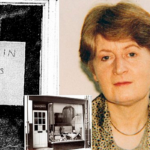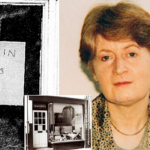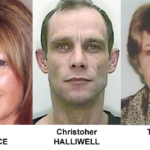Christopher Halliwell: The North West Clusters
by CHRIS CLARK & TIM HICKS
~~~~~
Introduction: “The East Lancs Ripper”
For many years there has been media comment on the possibility that a serial killer, dubbed “The East Lancs Ripper” and who remains undetected, had operated in East Lancashire in the period 1988-1998.
This man has been alleged to be responsible for the unsolved murders of Linda Donaldson, Maria Christina Requena, Julie Finlay and Vera Anderson. Manchester Evening News (MEN) report on the “East Lancs Ripper” here.
There has also been media comment that the suspicious disappearances of Helen Sage, Georgina Moore, Pauline Curry and the murder of Julie Jones may be connected to these murders. (MEN) report here.
New information has been revealed in the “In the Footsteps of Killers” documentary on the 1990 murder of Mrs Trevaline Evans in Llangollen, North Wales, in which Tim participated (here). Following on from this, the authors have re-reviewed these cases.
The authors eliminated three of these cases from the series in an article published in 2018.
- Vera Anderson
Vera Anderson was found with her throat cut in her car in Penketh near Warrington on the 25th of August 1991. The modus operandi of this crime was very different to those of the other cases. In 2022, Cheshire Police arrested a 70-year-old man from Widnes and a 61-year-old woman from Warrington for Vera’s murder, but they were released without charge.
- Georgina Moore
Georgina Moore was a divorced mother of two who disappeared from Wigan in 1998. She was reported as missing but was traced and found to be alive and well.
- Pauline Currie
Pauline Curry was a hairdresser and single parent, who disappeared from Lowton, near Leigh in November 2006. She was also traced and found to be alive and well.
The authors are nevertheless satisfied that the remainder of these cases are linked and form a cluster of attacks for which serial killer Christopher Halliwell (pictured above left), is a strong suspect. They also believe that Halliwell could be a suspect in the “Angel of the Meadows” murder and have now linked the murder of Trevaline Evans to the “East Lancs Ripper” series.
Christopher Halliwell
Halliwell is currently in prison on a full life sentence for the 2003 murder of Becky Godden-Edwards and the 2011 murder of Sian O’Callaghan. He was 47 when he murdered Sian O’Callaghan. It is rare for men to start killing at that age. Most serial killers start in their late teens and early twenties.
Halliwell was a misogynist from the age of 15. When he was aged twenty-one to twenty-three (in between 1985 and 1987), he boasted in prison to a cell-mate that he had already killed one woman and wanted to become a serial killer.
During the course of its investigation into Halliwell, Wiltshire Police discovered three “trophy caches” of sixty items of women’s clothing which it is suspected were taken from his victims. These were:
- A pond at Ramsbury, Wiltshire where they recovered Sian O’Callaghan’s boots (SO’C: D3).
- Buried near the pond they found Becky Godden-Edwards’ cardigan (BG-E: D4), fifty-eight other items of women’s clothing and a shotgun.
- Halliwell’s garage where they recovered a pair of knickers that did not belong to his wife or his daughter. The implication being that they were from a more recent, but unknown victim and were being stored in the garage prior to being transported to the cache at Ramsbury.
Detective Superintendent Steve Fulcher, who arrested Halliwell has been quoted as saying:
“Buried around the pond were more items of women’s clothing. I wondered, did they belong to the six other victims I suspected Halliwell of killing? But I had my maths wrong.
Around the pond were not six other items of women’s clothing. There were 60.
Halliwell might have been far more prolific than even I had feared.”
Daily Mail coverage with his remarks in full here.
In 1977 alone, Yorkshire Ripper Peter Sutcliffe murdered at least five women. So in the period following his release from prison in 1987 to his arrest in 2011, Halliwell could have murdered many more women than those for which he was convicted.
Serial killers prefer to operate in areas and follow routes they are familiar with because:
- They are more confident and comfortable in familiar surroundings.
- They know the patterns of behavior locally, which reduces the possibility of detection while they are committing a crime.
To assess the possibility of other crimes having been committed by a serial killer, it is necessary to identify the areas he was familiar with. Then compare his modus operandi to unsolved crimes in those areas.
Halliwell’s geographical area of operation
Halliwell led an itinerant life style. He enjoyed driving and travelled widely to work in many jobs, including window-cleaner, builder, ground-worker, chauffeur, taxi-driver and bin-man, and to pursue his hobbies of narrow-boating and fishing. He regularly used prostitutes and visited ‘red light’ districts.
Halliwell lived in Dalbeattie, Scotland, several addresses in Swindon and at Aughton Park near Liverpool. He is known to have stayed and worked in North Wales as a window fitter. He may also have stayed with his father in Huddersfield. According to one witness, he also lived in York and worked there as a minicab driver or a builder.
Consequently Halliwell’s geographic knowledge and area of operations was enormous. He certainly knew Lancashire, Liverpool, Manchester, Yorkshire and North Wales. This has led the authors to potentially link Halliwell to:
- A cluster of murders within a 40 mile radius of Aughton Park in Lancashire.
- A cluster of attacks in North Yorkshire, which are to be covered in a separate series of articles.
Halliwell’s modus operandi
The authors have analysed Haliwell’s modus operandi, based on the murders of Becky Godden-Edwards and Sian O’Callaghanfor which he was convicted.
Becky Godden-Edwards
Becky was a heroin addict and paid for her abduction through prostituting herself at Swindon’s Manchester Road red light district (RLD). Halliwell was a regular client and was obsessed with her. She was last seen getting into Halliwell’s cab outside a nightclub on East Street, Swindon, (Abduction Point BG-E: AP) in January 2003, while arguing with him.
When he was arrested, Halliwell took detectives to the exact location of Becky’s grave in the corner of a field in Eastleach (BG-E: D2), in the Gloucester Constabulary force area. Even though it was nondescript and he had buried her there eight years before. The implication being that he had visited the grave several times over the years to obtain pleasure from the memories it brought him.
Becky’s clothing had been removed. Her hands, feet and head were missing and Halliwell never revealed where he had buried them (BG-E: D3+), or the location where he dismembered her body (BG-E: D1). The cause of death could not be determined.
Sian O’Callaghan
Halliwell worked in Swindon as a minicab driver. In the early hours of the morning of 19th March 2011 he contacted his control room and told them he was clocking-off and going home. He then drove around Swindon, looking for a suitable victim.
Sian O’Callaghan (pictured above right), aged 22, was walking home from a nightclub on High Street Swindon and was spotted by Halliwell (SO’C: AP). She had facial similarities to Halliwell’s mother, (who he hated), had a slight build – which meant she could be easy to overcome. This all fitted his victim preferences. He pulled up in his green Toyota Avensis with a minicab sticker on the side and offered her a lift. Sian got in and Halliwell killed her shortly afterwards by stabbing her in her head and neck with a knife. Her body was later found to have been undressed and showed signs of strangulation and blunt force trauma to the face and head.
[See Map, here]
Halliwell took Sian’s body to the Savernake forest (SO’C: D1) and concealed it there, later visiting it four times. When he realised that the police were searching the Savernake Forest in the Wiltshire Police force area, he moved Sian’s body to the White Horse at Uffington, Oxfordshire, in the Thames Valley Police force area (SO’C: D2). He removed the body from the boot of his car and rolled it down an embankment into undergrowth, which completely concealed it from the road. He had obviously preselected the deposition site at Uffington and it was perfect for this purpose. The operation probably took less than two minutes.
Forensically aware, Halliwell later cleaned the rear seat of his car and burned the seat covers.
The Map
[See Map, here]
This summarises some of this information and shows that Halliwell moved both bodies in short journeys of between 11 and 19 miles in rural areas, at night. This reduced the possibility of being stopped by the Police in a traffic stop, being picked up on CCTV or being seen by other drivers or residents.
Halliwell was forensically aware. He changed cars regularly and destroyed forensic evidence whenever possible. He concealed Becky and Sian’s bodies with great skill. He was physically strong, had been a builder, grave-digger, and ground worker and could probably dig a shallow grave in an hour or so. Had he not taken detectives to the gravesites, their bodies would never have been found. The absence of a body is therefore entirely consistent with Halliwell’s modus operandi. The implication of this is that Halliwell must be a suspect in the disappearance of any woman in an area that Halliwell was known to frequent or operate in.
When he was working as a taxi driver, Halliwell was smartly dressed, clean and tidy in appearance, quiet spoken and persuasive. He had no difficulty persuading women to get in his vehicle.
The authors believe that he deliberately varied his modus operandi, and abducted victims in one force area, then deposited the body in another, to complicate the police investigation and make it more difficult to link his crimes
Table 1
[Link to Table 1, here]
This compares Halliwell’s modus operandi against the murders in the North West and Yorkshire clusters. As can be seen there is a clear correlation.
The North West clusters
[The map here shows]:
- The route packages Halliwell would probably have used when living at Aughton Park, working in North Wales and returning to Swindon.
- The two abduction clusters in Manchester and Liverpool, and a deposition cluster along the A570, A580 and A579. Containing the key sites for the “East Lancs Ripper” murders of Helen Sage, Linda Donaldson, Maria Christina Requena, Julie Finlay, Julie Jones and additionally, the “Angel of the Meadows” case.
- The key points in the murder of Trevaline Evans, which are linked to the “East Lancs Ripper” murders by the associated route packages.

Considering the individual cases:
Linda Donaldson
Linda Donaldson was a prostitute from Liverpool who was last seen at 11pm on Monday 17th October 1988, by a Merseyside Police vice squad officer close to the Albert Dock RLD waiting for clients. Detectives deduced that she was enticed into a car by a client.
At noon the next day, an elderly couple discovered Linda’s body along a remote stretch of road at Lowton, a village in Greater Manchester. Linda’s body was concealed on the other side of a hedge, in a gully. A post-mortem examination would later conclude that she had died from multiple stab wounds.
The pathologist concluded that the woman was dead before many of the injuries had been inflicted, including trying to remove her breasts, which were never found and trying to remove her head and arms from her body. The murder weapon(s) and Linda’s clothes were not found.
Linda’s body had been washed down before it was dumped, probably to remove any forensic evidence. She was killed somewhere else and then dumped in the field.
Crimewatch UK programme on the murder here.
Trevaline Evans
Trevaline Evans disappeared from her antiques shop at Llangollen North Wales in June 1990. Her murder is included in the North West Cluster because Halliwell could have travelled to Llangollen to go fishing or travelling on a narrow boat, using the route packages from Aughton Park to North Wales and from North Wales to and from Swindon. The key indicators are:
- Halliwell had a striking facial resemblance to Sian O’Callaghan and Claudia Lawrence, which in turn meant she resembled Halliwell’s mother.
- Llangollen is a centre for fishing and narrow boating.
- Halliwell is known to have worked as a window fitter in the North Wales area.
- A man resembling Halliwell was seen acting suspiciously near her shop.
- Halliwell had served a prison sentence for burglary in which he specialised in stealing antiques. He may have been trying to sell stolen antiques to Trevaline.
- Trevaline disappeared.
A recent television documentary in which Tim participated (here) gives the full facts and the latest information.
Trevaline’s murder is to be covered in detail in the next article in the series.
Maria Christina Requena
Maria Christina Requina (aged 26) was a prostitute who worked the Minsull Street RLD in Manchester. She disappeared on 1st January 1991.
Her dismembered body was found in five bin-bags by two youngsters fishing on the shores of Pennington Flash, off Slag Lane, on the 6th of January 1991. Maria had been stabbed to death, decapitated and her body cut up with power tools before being wrapped in a mattress cover and thrown into the lake. Her clothes and the murder weapon had been removed from the scene.
The Mirror report with more information here.
Julie Finley
Twenty three year old Liverpool prostitute Julie Finley was last seen alive about 11.00pm on Friday the 5th of August 1994, at the rear of the Liverpool Royal University Teaching Hospital, close to both the Albert Dock RLD and the Liverpool end of the Leeds and Liverpool Canal. She was witnessed talking to ‘an unknown white man, of average height and build, and aged in his 20s to 30s‘. A general description that nevertheless fits Halliwell.
She was found by a cyclist at lunchtime on Saturday the 6th of August 1994 in a field off the Rainford bypass. She had been strangled. There was no sign of her clothing at the scene and she had been murdered elsewhere.
A few hours before Julie’s body was discovered, a witness told police he saw someone matching her description arguing with a man at about 12.30am on Saturday, 6th August 1994 outside the Wheatsheaf Public House, situated only 50 yards from where her body was found. The unknown man was attempting to force this young woman into a white Transit van. Halliwell was driving a D-registration white van at the time.
Shortly after Julie’s murder, a woman calling herself Tina called police and told them that on the night of her murder, Julie said she was going to meet a taxi driver from Prescot. This man may have been a regular client. Halliwell is known to have worked as a taxi driver and was a regular client of Becky Godden-Edwards. Prescot is 6.5 miles from the deposition site at Rainford By-Pass.
Twenty people have been arrested in connection with this crime over the years, but no-one has been charged.
Liverpool Echo report with more information here.
Helen Sage
Helen Sage was a single mother who was devoted to her six month old daughter. She was forced to prostitute herself to make ends meet and was last seen in Manchester’s red light district in August 1997.
Helen was at one time suspected of being the Angel of the Meadows murder victim, but was eliminated.
Helen is still classified as missing, although the authors both believe she has been murdered. GMP commented. Detective Sergeant Clare Carr, from GMP’s Cold Case Unit, said:
“At the time of Helen’s disappearance a number of hypotheses were explored to establish what happened to her.
As with cases of this nature, this is normal procedure to make sure that every outcome is considered to try and find that person.
Helen’s disappearance is not currently being treated as murder as there has never been any physical evidence to suggest she was killed.
Of course, if any new information came to light we would review this.”
The proposition put forward by GMP above that after twenty six years with no proof of life that Helen is still alive clearly beggars’ belief. It is quite obvious she has been murdered and her body concealed:
- Helen was a devoted to her baby. It is highly unusual for mothers to abandon their children and this is normally the key indicator of a “no body” murder, which GMP isignoring.
- There was no reason for Helen to disappear.
- Helen’s only source of income was prostitution, yet has never come to the attention of the police since her disappearance.
- Prostitutes have to get into a car with an unknown man. This left Helen vulnerable to abduction and then murder at a remote crime scene. It is therefore impossible to detect physical evidence of crime at the pick-up point, because no crime is c omitted there. The crime occurs afterwards and consequently the crime scene in these cases is far away from the place the victim was last seen, secluded and undetectable by the police. In the case of a prostitute murder, the absence of any physical evidence does not rule out the possibility of murder.
The Helen Sage case is the same as the disappearance of Becky Godden-Edwards, which was only resolved eight years later when Christopher Halliwell led Wiltshire Police to her grave. There was no physical evidence of crime in that case either. The absence of physical evidence should not be used as the sole elimination criteria to automatically prevent the re-classification of Helen Sage’s disappearance as murder.
The conclusion is inescapable that Helen has been murdered and GMP is classifying her as a missing person to manipulate its crime figures to conceal an unsolved prostitute murder and avoid expending effort on a “fish and chip” murder. A classic case of misogynistic police attitudes to prostitutes.
Julie Jones
Julie Jones was a 32-year-old prostitute and mother of two, who worked the Whalley Range and Minshull Street RLDs in Manchester.
Her naked body was found under bushes at Shudehill Manchester on the 13th of July 1998, six days after she was reported missing. Like Linda Donaldson she was wrapped in a carpet. She had suffered crush injuries to her chest. Her clothes were never recovered.
MEN report with more information, details of the reward of £50,000 and the police appeal here.
The “Angel of the Meadows”
In 2010, builders found the body of an unidentified woman in an area known as Angel Meadow, central Manchester. She became known as the “Angel of the meadows”.
The body was wrapped in carpet, which probably came from a Ford Cortina. The carpet was burned, indicating an attempt to destroy forensic evidence, which is consistent with Halliwell. The post-mortem established she had been beaten to death and had a fractured neck, collarbone and jaw. The body had been stripped, some clothes were found nearby and she may have been sexually assaulted. She had probably been murdered between 1977 and 1988.
Initially there was speculation that the body may have been Helen Sage, but she was quickly ruled out. Despite extensive enquiries, the identity of the victim was never discovered. GMP interviewed murderers Ronald Castree, Peter Tobin and the “Rotherham Shoe Rapist” James Lloyd in connection with the murder.
The authors have included the “Angel of the Meadows” case in this analysis because Halliwell travelled widely and could have been in Manchester. The body had similar injuries to those of Sian O’Callaghan and had been buried. An attempt had been made to burn evidence. Like Sian O’Callaghan, footwear was removed from the scene.
The fact that the victim has not been identified may indicate that the body was brought in from outside of the city, or that the “Angel of the Meadows” was of no fixed abode or a prostitute.
MEN article with more information here.
The deposition cluster
Analysis of the deposition cluster is revealing. It is linear along 12 miles from the A570, A580 and A579.
Insert: The A570/580/A579 Linear Deposition Cluster Map
It is unclear when Halliwell was living at Aughton Park and working in North Wales, but because of his itinerant lifestyle, use of prostitutes and interest in fishing and narrow boating, it is entirely possible that he could have been familiar with all the abduction points and deposition sites in the clusters.
Other than Trevaline Evans, all the victims were of slight build, meaning that they would be easy to overpower.
Halliwell had an interest in fishing and narrow boating. The Leeds and Liverpool Canal goes from close to the Albert Dock RLD in Liverpool, passes Rainford and then on to the Pennington Wharf Marina at Leigh, where it becomes the Bridgewater Canal. The Bridgwater Canal then joins the Rochdale Canal which lead into the City Centre of Manchester. The Whalley Range RLD is 2.6 miles from the Rochdale Canal, the Minshull Street RLD is 100 yards from it. The Shudehill/Angel Meadows deposition site is 0.4 of a mile from the Rochdale Canal. Halliwell may have gone fishing at Pennington Flash while living in the Liverpool area or while his canal boat was moored at Pennington Wharf Marina.
If Halliwell used the RLDs in Liverpool and Manchester while he was at Aughton Park, he would have been familiar with these RLDs and the routes to and from them, including the, A570, A580 and A579.
Linda Donaldson was abducted in Liverpool in the Merseyside Police force area, but her body was dumped in the GMP force area. As with the murders of Sian O’Callaghan and Becky Godden-Edwards, this indicates an intention to complicate the investigation by crossing force boundaries.
Linda Donaldson’s body had been washed down to remove forensic evidence. This is entirely consistent with a forensically aware offender, such as Halliwell.
Maria Christina Requena’s body had been dismembered and wrapped in bin bags, which is consistent with the murder of Melanie Hall in Bath, that Halliwell has been linked with.
Three deposition sites were in rural areas, within 19 miles of the abduction point, which is entirely consistent with Halliwell’s modus operandi.
We know that Halliwell visited the sites of Becky Godden-Edwards grave and Sian O’Callaghan’s body, probably to obtain perverse sexual gratification. The pond at Ramsbury he used as a trophy store is a fishing spot which gave Halliwell a reason to visit it and loiter there. Halliwell may have deposited bodies and trophies close to the canal network so that he could visit the sites for the same purpose. Pennington Flash has good fishing. Halliwell worked at various jobs including bin man. There is a Waste & Recycling Centre about two miles from Pennington Flash.
The Intake Lane body search
According to this Daily Mirror article Merseyside Police re-opened the investigation into the murder of Julie Finlay in 2020 with Halliwell as a suspect. In November 2020 they conducted a search near Intake Lane, which is within 3 miles of the Rainford Bypass and 4 miles of Aughton Park. It is unclear if these two events are connected, but Merseyside Police issued this media statement:
“Officers were responding to reports suggesting a body had been historically buried on the land. An extensive search of the area has been carried out over the past seven days but nothing has been located.
The search was not linked to any historical Merseyside Police investigations.”
It is unclear who the victim is or where he or she was murdered, other than it wasn’t Merseyside. Although the body was presumably transported there from another force area, had been concealed and was searched for at one end of the deposition cluster. There is not enough evidence to link it to Halliwell.
Apart from Julie Finlay, so far as can be ascertained, Halliwell has never been considered as a suspect in any of these murders. Greater Manchester Police (GMP) and Merseyside Police have never formally linked any of these cases.
It would therefore appear that either a) the deposition of three or four bodies along a short stretch of road is coincidental, or b) the murders were committed by the same man.
Halliwell is a very strong candidate.
Maps by FAD
Appeal for Information
Anyone with information which could help the investigation team should contact Merseyside Police @ CrimestoppersUK, or via its social media desk @ MerPolCC, call 101, or the GMP Cold Case Review Unit (remainder) on 0161 856 5978, or anonymously to Crimestoppers on 0800 555 111.
If you think you can add to our analysis, please contact the NYE using our email address: news@nyenquirer.uk. All information will be treated in the strictest confidence.
UK Police Force Boundaries Map



























Comments are closed.